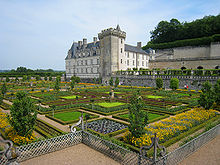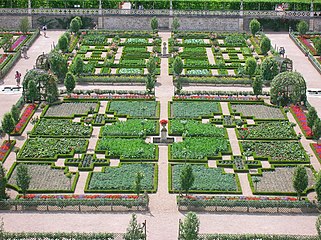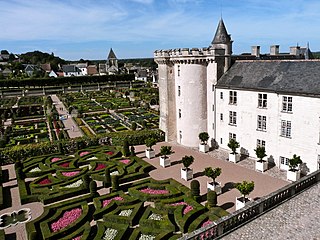Villandry Castle
Villandry Castle is a castle 15 kilometers west of the city of Tours in France . The municipality of Villandry is located on the Cher and is the last municipality before it flows into the Loire .
history
In the previous building of the castle, the fortress of Colombier from the 12th century, Henry II Plantagenet , King of England , signed the Peace of Colombier on July 4th 1189 after his defeat by Philip II Auguste, King of France .
The present castle was by Jean Le Breton , finance minister under I. Franz , built. The Gothic fortress was demolished in 1532, except for the foundations and the keep . The castle, one of the last Renaissance -style castles on the Loire , was completed along with a large garden in 1536 . Medieval elements such as decorative turrets and machicolations and Italian influence are almost entirely absent. This simpler, completely French style heralds the Anet , Fontainebleau and Henry IV castles with its roof shape .
In 1705, the Marquis de Castellane , who came from a Provencal family, took over the castle and had it rebuilt according to the comfort requirements of the 18th century. The garden was laid out as an English landscape garden. In 1823 the Hainguerlot family acquired the property, which remained in the family's hands until 1897. In 1906 the castle was bought and restored by Joachim Carvallo and the rich American Ann Coleman. They had the French gardens laid out in the 16th century style in line with the corrected Renaissance architecture of the castle. The castle has been open to the public since 1920. The current owner, Henri Carvallo, is the great-grandson of Joachim Carvallo.
Gardens
The gardens, reconstructed from old engravings, plans and gardening guides, are on three levels. At the top are the sun garden and near the palace the terraces with the Belvedere, the water garden a little lower. Its water basin feeds the garden moats, which merge into the castle moats (graves).
Ornamental gardens
On the level below there are ornamental gardens with ornamental beds made of boxwood . The “garden of love” directly behind the castle is laid out in squares that symbolize tender, passionate, inconstant and tragic love. It was created by Antonio Lozano and Javier de Winthuysen. Furthermore, there is a cloister garden and a music garden. In 1970 a herb garden was laid out, in 2008 a sun garden. The gardens have been managed in a non-toxic manner since 2009.
Kitchen garden
The multi-colored kitchen garden , which consists of nine squares, extends over the lowest level . The vegetable plants of all kinds, which are grown in compartments arranged in a checkerboard pattern and bordered with box, are only used for ornamental purposes. You can find red cabbage, endive, leek, beetroot, heads of lettuce and Swiss chard. At the crossroads of the paths there are fountains, at the corners arbours with roses. Pear trees, cut in a conical shape, were planted in the beds themselves. The planting of the squares is rotated every year to prevent soil depletion. This type of planting goes back to the Middle Ages. In monasteries, vegetable beds were often arranged in geometric shapes and embellished with tall rose bushes. The fountains, gazebos and flower beds in Villandry, on the other hand, show the Italian influence on horticulture.
meaning
Villandry Castle is best known for its gardens, which are a rare example of a complete Renaissance garden - even if it is a reconstruction. They are the subject of many reflections on the history of horticulture.
- Views of the Villandry Gardens
literature
- Alix de Guitaut-Vienne: Joachim Carvallo et l'Oeuvre de la demeure historique . Le Cercle du patrimoine, 2004, ISBN 3-9522154-6-5 .
Individual evidence
- ↑ Louis-Michel Nourry: Les jardins de Villandry: La Nature mise en ordre. in: Les destinées du patrimoine , Verlag Belin-Herscher 2002, ISSN 1624-687X , p. 114
- ↑ a b http://www.chateauvillandry.fr/en/history/the-gardens-of-villandry-are-restored-to-their-renaissance-glory/
- ^ Arend Jan van der Horst, Art of the formal Garden. London, Cassell & Co., 1995, 97
Web links
- Castle website (English, French)
- Villandry Castle - France's official website (German)
Villandry Castle as a 3D model in the 3D warehouse from SketchUp Witschftschafts building of the castle as a 3D model in the 3D warehouse from SketchUp
Coordinates: 47 ° 20 ′ 26 ″ N , 0 ° 30 ′ 46 ″ E














